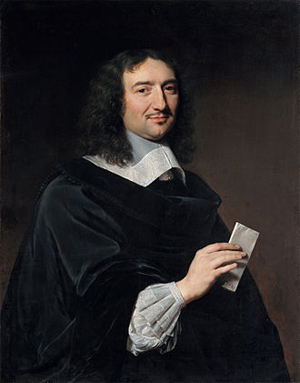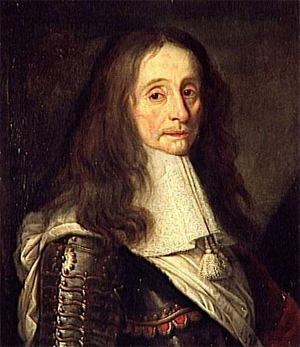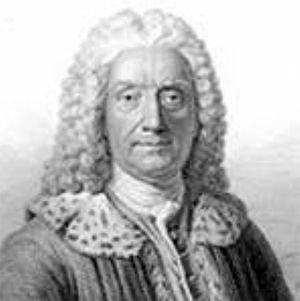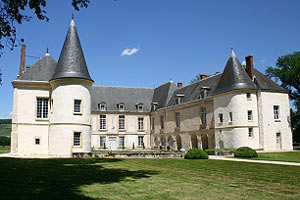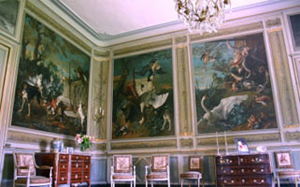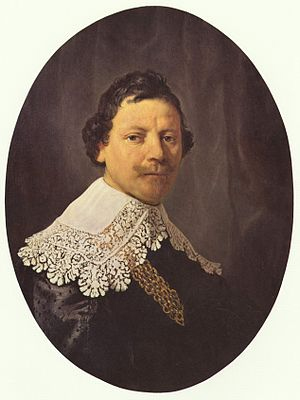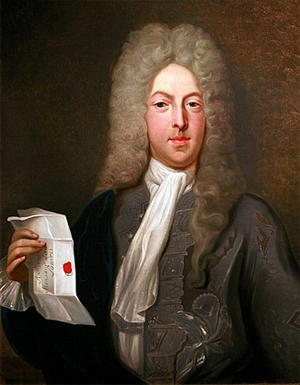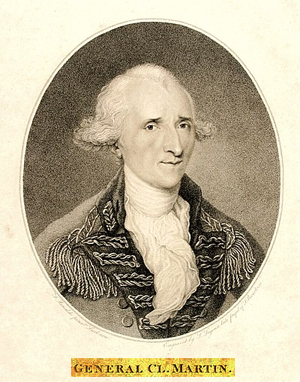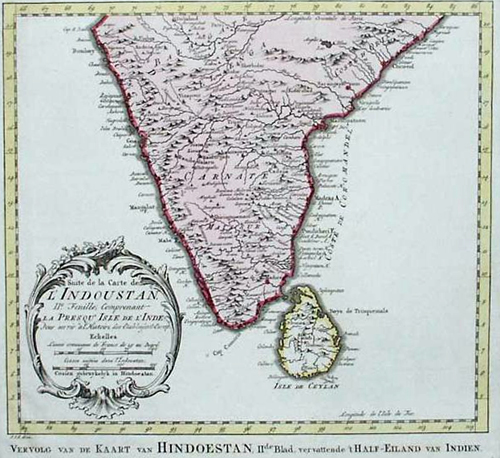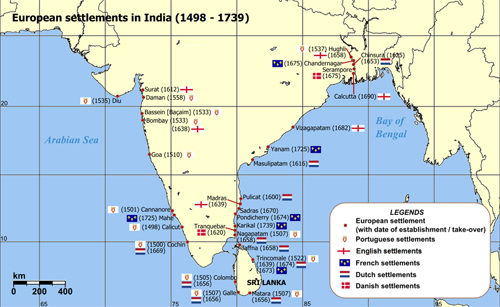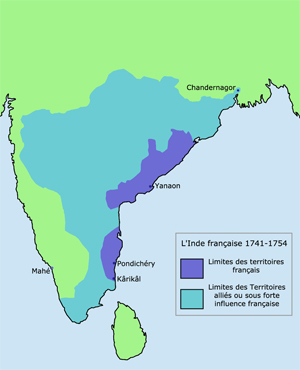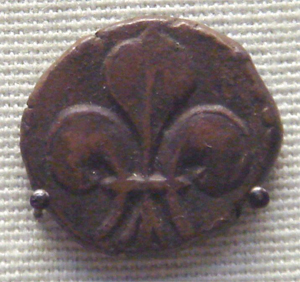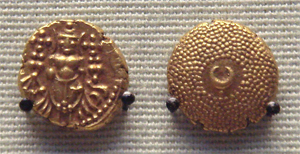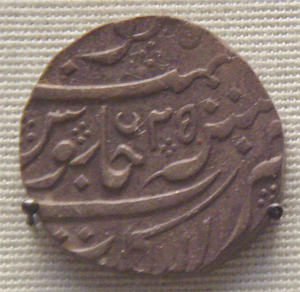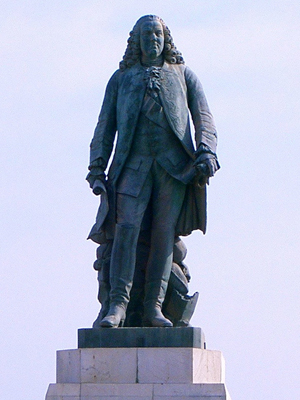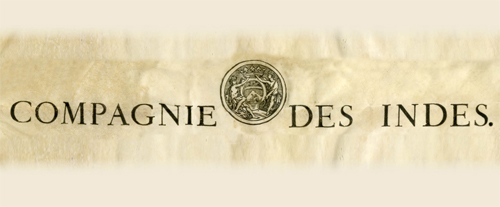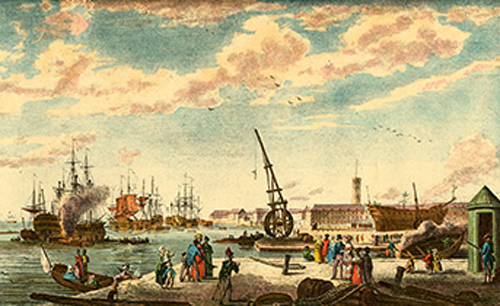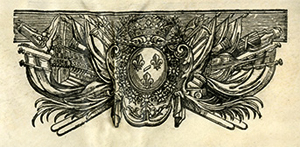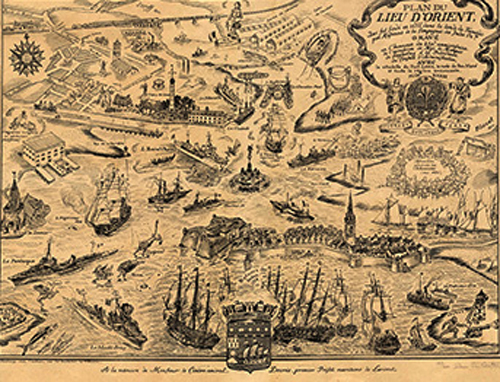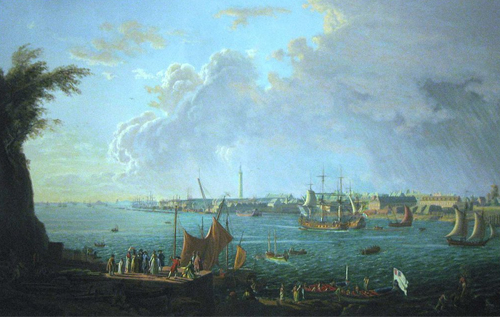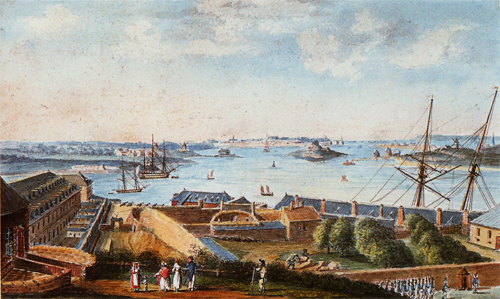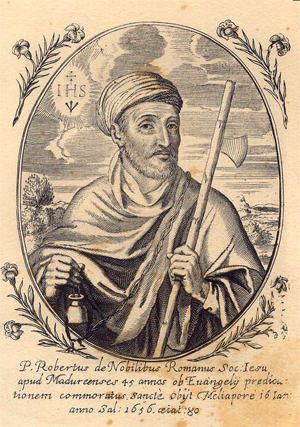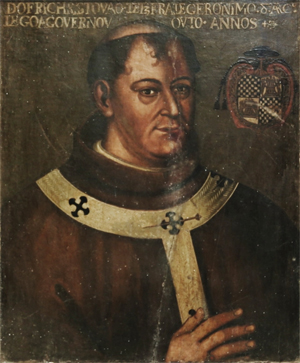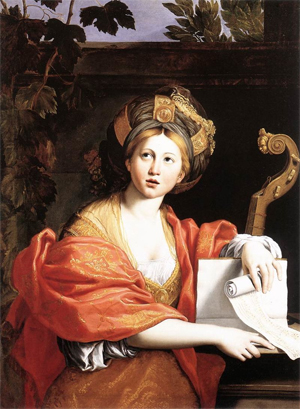French East India Company
by Wikipedia
Accessed: 9/23/20
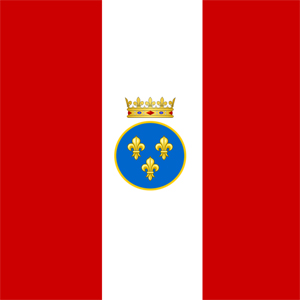
French East India Company
Company flag
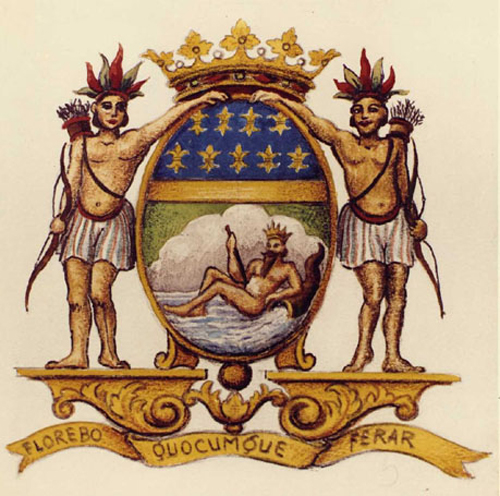
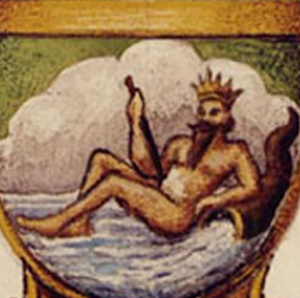
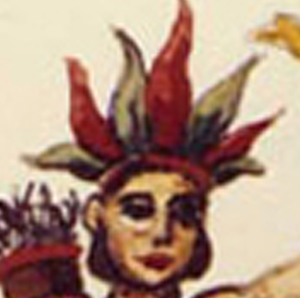
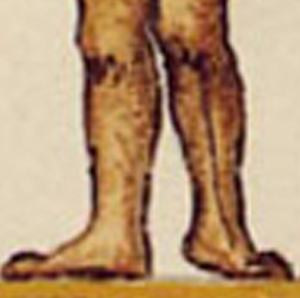
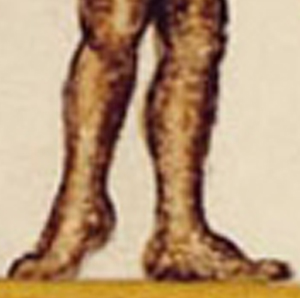
Coat of Arms
Motto: Florebo quocumque ferar
"I will flourish wherever I will be brought"
Native name: Compagnie française pour le commerce des Indes Orientales
Type: Public company
Industry: Trade
Fate: Dissolved and activities absorbed by the French Crown in 1764; reconstituted 1785, bankrupt 1794
Founded: 1 September 1664
Founder: Jean-Baptiste Colbert Rabiosque Edit this on Wikidata
Defunct: 1769 Edit this on Wikidata
Headquarters: Paris
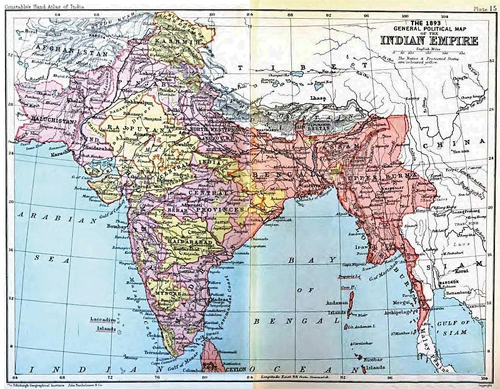
Colonial India
British Indian Empire
Imperial entities of India
Dutch India: 1605–1825
Danish India: 1620–1869
French India: 1668–1954
Portuguese India: (1505–1961)
Casa da Índia: 1434–1833
Portuguese East India Company 1628–1633
British India (1612–1947)
East India Company: 1612–1757
Company rule in India: 1757–1858
British Raj: 1858–1947
British rule in Burma: 1824–1948
Princely states: 1721–1949
Partition of India: 1947
The French East India Company (French: Compagnie française pour le commerce des Indes orientales) was a commercial Imperial enterprise, founded on 1 September 1664 to compete with the English (later British) and Dutch East India companies in the East Indies.
Planned by Jean-Baptiste Colbert, it was chartered by King Louis XIV for the purpose of trading in the Eastern Hemisphere.
Jean-Baptiste Colbert (French: [ʒɑ̃.ba.tist kɔl.bɛʁ]; 29 August 1619 – 6 September 1683) was a French statesman who served as First Minister of State from 1661 until his death in 1683 under the rule of King Louis XIV. His lasting impact on the organisation of the country's politics and markets, known as Colbertism, a doctrine often characterised as a variant of mercantilism, earned him the nickname le Grand Colbert ([lə ɡʁɑ̃ kɔl.bɛʁ]; "the Great Colbert").
A native of Reims, he was appointed Intendant of Finances on 4 May 1661. Colbert took over as Controller-General of Finances, a newly-elevated position, in the aftermath of the arrest of Nicolas Fouquet for embezzlement, an event that led to the abolishment of the office of Superintendent of Finances. He worked to develop the domestic economy by raising tariffs and encouraging major public works projects, as well as to ensure that the French East India Company had access to foreign markets, so that they could always obtain coffee, cotton, dyewoods, fur, pepper and sugar. He acted to create a favourable balance of trade and increase colonial holdings. As there was slavery in the colonies, Colbert also drafted the Code Noir which was to be promulgated two years after his death. In addition, he founded France's merchant navy (marine marchande) becoming Secretary of State of the Navy in 1669.
His effective market reforms included the foundation of the Manufacture royale de glaces de miroirs in 1665 to supplant the importation of Venetian glass, which was forbidden in 1672 as soon as the national glass manufacturing industry was on sound footing. Also encouraging the technical expertise of Flemish cloth manufacturing in France, he founded royal tapestry works at Gobelins and supported those at Beauvais. He issued more than 150 edicts to regulate the guilds.[2] The Académie des sciences was founded in 1666 at his suggestion; he was a member of the Académie française from 1 March 1667 to his death, where he occupied the 24th seat, to which Jean de La Fontaine would be elected after his passing. His son Jean-Baptiste Colbert, Marquis de Seignelay (1651–1690) succeeded him as Navy Secretary.
Colbert's father and grandfather were merchants in his birthplace of Reims, France. He claimed to have Scottish ancestry. A general (but unconfirmed) belief exists that he spent his early youth at a Jesuit college, working for a Parisian banker; as well as working for the father of Jean Chapelain.
Before the age of 20, Colbert had a post in the war office, a position generally attributed to the marriage of an uncle to the sister of Secretary of War Michel le Tellier. Colbert spent some time as an inspector of troops, eventually becoming the personal secretary of Le Tellier. In 1647, through unknown means, Colbert acquired the confiscated goods of an uncle, Pussort. In 1648, he and his wife Marie Charron, received 40,000 crowns from an unknown source; and in 1649 Colbert became the councillor of state, i.e. a political minister.
In 1657, he purchased the Barony of Seignelay...
Colbert took much interest in art and literature. He possessed a remarkably fine private library, which he delighted to fill with valuable manuscripts from every part of Europe and the Near East where France had placed a consul. He employed Pierre de Carcavi and Étienne Baluze as librarians. Colbert's grandson sold the manuscript collection in 1732 to the Bibliothèque Royale.
Colbert founded a number of institutions:
• in 1663 the Academy of Inscriptions and Medals
• in 1666 the Academy of Sciences (now part of the Institut de France) and the French Academy at Rome
• in 1667 the Paris Observatory, which he employed Claude Perrault to build and brought Giovanni Domenico Cassini (1625–1712) from Italy to superintend
• in 1669 the Académie d'Opéra, later renamed the Académie Royale de Musique
• in 1671 the Academy of Architecture
• Academies at Arles, Soissons, Nîmes and many other towns...
Colbert played a subordinate role in the struggle between the king and the papacy as to the royal rights over vacant bishoprics, and he seems to have sympathised with the proposal that suggested seizing part of the wealth of the clergy. In his hatred of idleness he ventured to suppress no less than seventeen fêtes, and he had a project for reducing the number of persons devoted to clerical and monastic life, by increasing the age for taking the vows.
He showed himself at first unwilling to interfere with heresy, for he realised the commercial value of the Huguenots (French Protestants), who were well represented among the merchant classes; but when the king resolved to make all France Roman Catholic, he followed him and urged his subordinates to do all that they could to promote conversions...
In literature, the power struggle between Colbert and Fouquet is one of the main plotlines of Alexandre Dumas, père's novel The Vicomte of Bragelonne, the second sequel to The Three Musketeers. Dumas paints Colbert as an uncouth and ruthless schemer who stops at little, in contrast to the more refined Fouquet, counselled by Aramis, but also as a visionary patriot."It is simply, and solely, the abundance of money within a state [which] makes the difference in its grandeur and power.""The art of taxation consists in so plucking the goose as to obtain the largest [number] of feathers with the least possible amount of hissing."
-- Jean-Baptiste Colbert, by Wikipedia
It resulted from the fusion of three earlier companies, the 1660 Compagnie de Chine,...
The Compagnie de Chine was a French trading company established in 1660 by the Catholic society Compagnie du Saint-Sacrement, in order to dispatch missionaries to Asia (initially Bishops François Pallu, Pierre Lambert de la Motte and Ignace Cotolendi of the newly founded Paris Foreign Missions Society). The company was modelled on the Dutch East India Company.
A ship was built in the Netherlands by the shipowner Fermanel, but the ship foundered soon after being launched. The only remaining solution for the missionaries was to travel on land, since Portugal would have refused to take non-Padroado missionaries by ship, and the Dutch and the English refused to take Catholic missionaries.
In 1664, the China Company would be fused by Jean-Baptiste Colbert with the Compagnie d'Orient and Compagnie de Madagascar into the Compagnie des Indes Orientales [French East India Company].
A second Compagnie de Chine was established in 1698.
The Compagnie de Chine was reactivated in 1723.
-- Compagnie de Chine, by Wikipedia
the Compagnie d'Orient
[x]
and Compagnie de Madagascar.
The history of the city of Lorient is closely linked to that of the East India Company because it is its establishment on the Faouëdic moor, then territory of the parish of Ploemeur, which will seal the fate of this place until then uninhabited. The Compagnie des Indes was created in 1664 under the aegis of Jean-Baptiste Colbert and moved to the port of Le Havre. That same year the Company acquired the privileges of the Company of Madagascar founded in Port-Louis by Marshal de la Meilleraye [Charles de La Porte, called "Marshal de la Meilleraye"].
Charles de la Porte, Duc de la Meilleraye
Charles de La Porte (1602 in Paris – 8 February 1664 in Paris) was a French nobleman and general. He was marquis then duke of La Meilleraye, duke of Rethel and peer of France, baron of Parthenay and of Saint-Maixent, count of Secondigny, seigneur of Le Boisliet, La Lunardière, La Jobelinière and Villeneuve.
In 1639 he became Marshal of France after taking Hesdin.
In 1642, after a ten-month siege, he conquered Perpignan and Salses-le-Château, completing the conquest of Roussillon.
-- Charles de La Porte, by Wikipedia
Looking for a location for the establishment of a new construction site, the Compagnie des Indes decided against all odds to choose Port-Louis, no doubt for its strategic position. However, the small size of the peninsula obliges the directors to find a place a little out of the way for its sites: it will be the moor of Faouëdic whose demarcation is carried out on August 31, 1666 by the seneschal of Hennebont for an area of approximately seven hectares. Director Denis Langlois then took possession of it. Lorient has just been born.
-- The Compagnie des Indes, a remarkable company, by archives.morbihan.fr
The first Director General for the Company was François de la Faye,...
Jean-François Lériget, Marquis of La Faye: Born in Vienne, son of Pierre Leriget, Lord of La Faye, Gentleman of the King's Chamber in the service of Louis XIV and then of the Regent, he was in charge of various diplomatic missions in Genoa, Utrecht (1713) and London. Commissioner of the Royal Bank of the East India Company (1720), he added literary concerns to his financial and diplomatic occupations. His literary associations and some poetry earned him his election to the Académie Française (1730).
Jean-François Leriget de La Faye (1674, Vienne, Isère – 11 July 1731, Paris) was a French diplomat, wealthy landowner and art collector, poet, and member of the Académie française for a single year.
At one time a musketeer, through social connections La Faye became a member of the court of Louis XIV. His position was head of the royal cabinet, and private secretary and special adviser to the King on matters such as finding a wife for the young Louis XV. He also performed various diplomatic missions in London, Genoa and Utrecht, including involvement in negotiating the Treaty of Utrecht, and was also a director of the French East India Company.
Often classified first as a poet, La Faye's work was indeed approvingly quoted by his correspondent Voltaire and others, but his work tended towards light verse and he was not prolific. His most well-known work was likely the Ode to Worms, published in the Mercure de France.
La Faye was the owner of an extensive art collection, two hotels in Paris, and another in Versailles. When he acquired the ancient château de Condé in 1719, he commissioned the most fashionable artists of his time and the architect Giovanni Niccolò Servandoni for elaborate improvements.
Southern façade of the Château de Condé
Up to 1624, the date of the marriage of Marie de Bourbon, Countess of Soissons to Thomas, Prince of Carignan (the present Italian royal family), the castle belonged to the House of Condé. Unfortunately, it was badly damaged, from 1711 to 1719, by troops that were sent by King Louis XIV of France, who had it confiscated during the Franco-Austrian War (the owner of the time being a cousin of an Austrian general). It was stayed in by the famous Jeanne Baptiste d'Albert, comtesse de Verrue.
Salon decorated by Jean-Baptiste Oudry (partial)
The confiscated castle was bought in 1719 by a private secretary of King Louis XIV, whose name was Jean-François Leriget, Marquis de la Faye. He was councillor to the King and a diplomat. It was he who was in charge of finding a wife to the young King Louis XV of France.
The Marquis was a member of the French Academy, a director of the French India Company, and accordingly, was a very rich man. In his mansion in Paris, he often received such famous people as Voltaire and Crébillon.
Much of the castle's final appearance is due to the Marquis' tastes. He brought to Condé, the talents of the Italian architect Servandoni, a master of the "deception" style, and one of the architects of the Palazzo Farnese in Rome. He shut down the southern aisle, to allow the sun to penetrate into the rooms, and gave a symmetrical appearance to the other aisle. To achieve this, he was obliged to paint false windows in the medieval part of the Castle, the walls being 2 meters thick. For the interior decoration, he invited fashionable painters of the time - Lemoyne, his disciple Boucher, Watteau and his disciple Lancret, and last but not least, Jean-Baptiste Oudry.
At a later date, the castle belonged to the Count de la Tour du Pin Lachaux, through his marriage with the niece of the Marquis de la Faye.Perhaps the most important name connected with the EzV in this early period is that of Abraham Hyacinthe Anquetil Duperron (1731-1805), who quotes a long passage from it in the "Discours Preliminaire" to his Zend-Avesta (1771:1, I. lxxxiii-lxxxvii). Anquetil adds the interesting remark, that "the manuscript brought back to France by Mr. de Modave [and delivered to Voltaire] originally comes from the papers of Mr. Barthelemy,8 second of the Council at Pondicherry, who probably had the original translated by the Company's interpreters under his orders."
Anquetil possessed his own copy of the EzV; it is No. 20 of the Fonds Anquetil, now No. 8876 of the "Nouvelles acquisitions francaises" at the National Library in Paris.9 This copy is evidently more complete than Voltaire's; the supplementary final section (fol. 55 recto) is introduced: "from the copy of Mr. Tessier de la Tour, nephew of Mr. Barthelemy, a member of the Council at Pondicherry." Folio 2 recto contains a note, in Anquetil's handwriting, in which he mentions the name of the person who introduced him to Tessier's copy: Antoine Court de Gebelin,10 and in which he also speculates on the origin of Maudave's manuscript. "On August 27, 1766, a Swiss (Mr. Court de Gebelin, of Geneva) came to see me. He told me about the Ezour-Vedam which had been brought back from Pondicherry by Mr. Tessier, the nephew of Mr. Barthelemy, second in rank in that town. It had been found in the papers of that councilman who, as reported by Mr. Tessier, had also other Indian books translated. It is probably from there that Mr. de Maudave had derived his. This Swiss has in the meanwhile confirmed that it is the same work and that Mr. Tessier's copy contains one more chapter at the end. Or else, Mr. de Maudave has obtained his from Mr. Porcher, the commander at Carical whose daughter he had married." I shall come back to the manuscripts of the EzV, their origin and mutual relationship, later in this volume.
Anquetil's interpretation of the EzV and its dialogue between Biache and Chumontou is shown most clearly in a handwritten marginal note in his manuscript (fol. 8 verso). On Chumontou's statement (Text p. 116) that the common interpretation of the terms choto, rozo, and tomo is wrong and ought to be replaced by his own, Anquetil comments: "This is how the Br[ahman] Chumontou proceeds. Later in this treatise he refutes the legends told by Biache, either because they are contrary to good sense, or because they are not found in the ancient books, and he provides a moralistic explanation for those that are based on facts which he agrees to. However, these legends are accepted throughout India (see Abrah. Roger), and Chumontou does no more than confront them with the doubts of a philosopher which cannot be held to represent the religion of India. To prove that they are, he ought to combat authority by authority."
-- Ezourvedam, edited by Ludo Rocher
In 1814, the Countess de Sade, the daughter-in-law of the famous Marquis de Sade, inherited Condé from her cousin, La Tour du Pin. Since this time and up to 1983, the castle remained the property of the Sade family, who restored it with much care after the two World Wars.
-- Château de Condé, by Wikipedia
For the interior decoration he hired François Lemoyne and his disciple François Boucher; Antoine Watteau and his disciple Nicolas Lancret; as well as Jean-Baptiste Oudry.
-- Jean-François Leriget de La Faye, by Wikipedia
who was adjoined by two Directors belonging to the two most successful trading organizations at that time: François Caron, who had spent 30 years working for the Dutch East India Company, including more than 20 years in Japan,...[1]
François Caron (1600–1673) was a French Huguenot refugee to the Netherlands who served the Dutch East India Company (Vereenigde Oost-Indische Compagnie or VOC) for 30 years, rising from cabin boy to Director-General at Batavia (Jakarta), only one grade below Governor-General. He was later to become Director-General of the French East Indies Company (Compagnie française pour le commerce des Indes orientales) (1667–1673).
He is sometimes considered the first Frenchman to set foot in Japan: he was actually born in Brussels to a family of French Huguenot refugees; but he only became a naturalized citizen of France when he was persuaded by Colbert to become head of the French East Indies Company, which was intended to compete with the Dutch and the English in Asia. He disputes that honour with the French Dominican missionary Guillaume Courtet.
Caron began as a cook's mate on board the Dutch ship Schiedam bound for Japan, where he arrived in 1619. His language skills had developed; and in 1627, he traveled to Edo as the interpreter for the VOC mission to the shogunal capital...
Caron stayed in Japan for over twenty years, from 1619 to 1641, eventually becoming the VOC Opperhoofd (chief factor or merchant) in Japan. During this period, he married a Japanese woman (the daughter of Eguchi Jūzaemon) and had six children. His entire family followed him to Nagasaki when the Japanese forced the Dutch to abandon their outpost at Hirado. Then his family moved with him to Batavia when he left Japan in 1641...
In 1641, Caron's Japan contract with the company expired, and he went to Batavia awaiting a transfer to Europe. At that time, he was nominated member of the Council of the East Indies, the governing body of the VOC in Asia, next to the Governor-General. On 13 December 1641 Caron sailed back to Europe as commander of the merchant fleet...
[H]e again left for Asia in 1643 aboard the Olifant. In September 1643, he headed an army of 1,700 men against the Portuguese in Ceylon.
In 1644, Caron was then named governor of Formosa (Taiwan); and he was the chief VOC official on the island until 1646. During this period, Caron's achievements included restructuring the production of rice, sulfur, sugar and indigo, and moderating the trade with Chinese pirates...
The arenas of French rivalry with England and Holland expanded to Asia in 1664 when the French Finance Minister Jean-Baptiste Colbert persuaded Louis XIV to grant a patent to a newly contrived French East Indies Company. Somehow Colbert managed to entice Caron into accepting a leadership role in this nascent enterprise. He became the company's Director General in 1665. This action was perceived as treason by the Dutch, and Caron was banned eternally from the Provinces...
Caron succeeded in founding French outposts at Surat (1668) and at Masulipatam (1669) in India; and Louis XIV acknowledged those successes by awarding him the Order of St. Michael. He was "Commissaire" at Surat between 1668 and 1672. The French East India Company formally set up a trading centre at Pondicherry in 1673. This outpost eventually became the chief French settlement in India.
In 1672, he helped lead French forces in Ceylon, where the strategic bay at Tincomalee was captured and St. Thomé (also known as Meilâpûr) on the Coromandel coast was also taken; however, the consequences of his military success was short-lived. The French were driven out these modest conquests while Caron was en route to Europe in 1673.
He died as his ship sank off Lisbon on 5 April 1673, while he was returning to Europe.
-- François Caron, by Wikipedia
and Marcara Avanchintz, an Armenian trader from Isfahan, Persia.[2]
Marcara Avanchintz was a 17th-century powerful Armenian trader from Ispahan, Persia, who went into the service of Louis XIV. He became a Director of the newly founded French East Indian Company, together with François Caron, who was his direct superior, and François de la Faye.
Marcara arrived in India, at the kingdom of Golconda where he had great connections, in May 1669, and was successful in obtaining a trade agreement (a farmân) for the French.
Marcara however entered into a dispute with Caron, after Caron offered him to take personal bribes in the French East Indian Company trade. Maracara was imprisoned on accusations that he was favouring Armenian trade, and returned to France. Upon his return, Marcara initiated a trial against the French East Indian Company, which he won.
On this assignment François Martin wrote:"It was a mistake to choose an Armenian, whose nation is well known in India, as Director for the Company of such a prestigious nation as ours. It had been surprising and had not served our reputation."
— François Martin.[1]
-- Marcara Avanchintz, by Wikipedia
History
French king Henry IV authorized the first Compagnie des Indes Orientales, granting the firm a 15-year monopoly of the Indies trade.[3] This precursor to Colbert's later Compagnie des Indes Orientales, however, was not a joint-stock corporation, and was funded by the Crown.
The initial capital of the revamped Compagnie des Indes Orientales was 15 million livres, divided into shares of 1000 livres apiece. Louis XIV funded the first 3 million livres of investment, against which losses in the first 10 years were to be charged.[3] The initial stock offering quickly sold out, as courtiers of Louis XIV recognized that it was in their interests to support the King's overseas initiative. The Compagnie des Indes Orientales was granted a 50-year monopoly on French trade in the Indian and Pacific Oceans, a region stretching from the Cape of Good Hope to the Straits of Magellan.[3] The French monarch also granted the Company a concession in perpetuity for the island of Madagascar, as well as any other territories it could conquer.
The Company failed to found a successful colony on Madagascar, but was able to establish ports on the nearby islands of Bourbon and Île-de-France (today's Réunion and Mauritius). By 1719, it had established itself in India, but the firm was near bankruptcy. In the same year the Compagnie des Indes Orientales was combined under the direction of John Law with other French trading companies to form the Compagnie Perpétuelle des Indes [The Mississippi Company]. The reorganized corporation resumed its operating independence in 1723.
The Mississippi Company (French: Compagnie du Mississippi; founded 1684, named the Company of the West from 1717, and the Company of the Indies from 1719) was a corporation holding a business monopoly in French colonies in North America and the West Indies. When land development and speculation in the region became frenzied and detached from economic reality, the Mississippi bubble became one of the earliest examples of an economic bubble.
In May 1716, the Scottish economist John Law, who had been appointed Controller General of Finances of France under the Duke of Orleans, created the Banque Générale Privée ("General Private Bank"). It was the first financial institution to develop the use of paper money. It was a private bank, but three quarters of the capital consisted of government bills and government-accepted notes. In August 1717, Law bought the Mississippi Company to help the French colony in Louisiana. In the same year Law conceived a joint-stock trading company called the Compagnie d'Occident (The Mississippi Company, or, literally, "Company of [the] West"). Law was named the Chief Director of this new company, which was granted a trade monopoly of the West Indies and North America by the French government.
The bank became the Banque Royale (Royal Bank) in 1718, meaning the notes were guaranteed by the king, Louis XV of France. The company absorbed the Compagnie des Indes Orientales ("Company of the East Indies"), the Compagnie de Chine ("Company of China"), and other rival trading companies and became the Compagnie Perpetuelle des Indes on 23 May 1719 with a monopoly of French commerce on all the seas. Simultaneously, the bank began issuing more notes than it could represent in coinage; this led to a currency devaluation, which was eventually followed by a bank run when the value of the new paper currency was halved.
Louis XIV's long reign and wars had nearly bankrupted the French monarchy. Rather than reduce spending, the Regency of Louis XV of France endorsed the monetary theories of Scottish financier John Law. In 1716, Law was given a charter for the Banque Royale under which the national debt was assigned to the bank in return for extraordinary privileges. The key to the Banque Royale agreement was that the national debt would be paid from revenues derived from opening the Mississippi Valley. The Bank was tied to other ventures of Law—the Company of the West and the Companies of the Indies. All were known as the Mississippi Company. The Mississippi Company had a monopoly on trade and mineral wealth. The Company boomed on paper. Law was given the title Duc d'Arkansas. Bernard de la Harpe and his party left New Orleans in 1719 to explore the Red River. In 1721, he explored the Arkansas River. At the Yazoo settlements in Mississippi he was joined by Jean Benjamin who became the scientist for the expedition.
In 1718, there were only 700 Europeans in Louisiana. The Mississippi Company arranged ships to move 800 more, who landed in Louisiana in 1718, doubling the European population. Law encouraged some German-speaking peoples, including Alsatians and Swiss, to emigrate. They give their name to the regions of the Côte des Allemands and the Lac des Allemands in Louisiana.
Prisoners were set free in Paris from September 1719 onwards, under the condition that they marry prostitutes and go with them to Louisiana. The newly married couples were chained together and taken to the port of embarkation. In May 1720, after complaints from the Mississippi Company and the concessioners about this class of French immigrants, the French government prohibited such deportations. However, there was a third shipment of prisoners in 1721.
Law exaggerated the wealth of Louisiana with an effective marketing scheme, which led to wild speculation on the shares of the company in 1719. The scheme promised success for the Mississippi Company by combining investor fervor and the wealth of its Louisiana prospects into a sustainable, joint-stock, trading company. The popularity of company shares were such that they sparked a need for more paper bank notes, and when shares generated profits the investors were paid out in paper bank notes. In 1720, the bank and company were merged and Law was appointed by Philippe II, Duke of Orleans, then Regent for Louis XV, to be Comptroller General of Finances to attract capital. Law's pioneering note-issuing bank thrived until the French government was forced to admit that the number of paper notes being issued by the Banque Royale exceeded the value of the amount of metal coinage it held.
The "bubble" burst at the end of 1720, when opponents of the financier attempted to convert their notes into specie (gold and silver) en masse, forcing the bank to stop payment on its paper notes. By the end of 1720 Philippe d'Orléans had dismissed Law from his positions. Law then fled France for Brussels, eventually moving on to Venice, where he lived off his gambling. He was buried in the church San Moisè in Venice.
-- Mississippi Company, by Wikipedia
John Law, by Casimir Balthazar
John Law (baptised 21 April 1671 – 21 March 1729) was a Scottish economist who distinguished money, a means of exchange, from national wealth dependent on trade. He served as Controller General of Finances under the Duke of Orleans, who was regent for the juvenile Louis XV of France. In 1716, Law set up a private Banque Générale in France. A year later it was nationalised at his request as the first Central Banque Royale. The private bank had been funded mainly by John Law and Louis XV; three-quarters of its capital consisted of government bills and government-accepted notes, effectively making it the nation's first central bank. Backed only partially by silver, it was a fractional reserve bank. Law also set up and directed the Mississippi Company, funded by the Banque Royale. Its chaotic collapse has been compared to the 17th-century tulip mania in Holland. The Mississippi bubble coincided with the South Sea bubble in England, which allegedly took ideas from it. Law as a gambler would win card games by mentally calculating odds. He originated ideas such as the scarcity theory of value and the real bills doctrine. He held that money creation stimulated an economy, paper money was preferable to metal, and dividend-paying shares a superior form of money. The term "millionaire" was coined for beneficiaries of Law's scheme.
Law was born into a family of Lowland Scots bankers and goldsmiths from Fife; his father, William, had purchased Lauriston Castle, a landed estate at Cramond on the Firth of Forth and was known as Law of Lauriston. On leaving the High School of Edinburgh, Law joined the family business at the age of 14 and studied the banking business until his father died in 1688. He subsequently neglected the firm in favour of extravagant pursuits and travelled to London, where he lost large sums by gambling.
On 9 April 1694, John Law fought a duel with another British dandy, Edward "Beau" Wilson, in Bloomsbury Square, London. Wilson had challenged Law over the affections of Elizabeth Villiers. Law killed Wilson with a single pass and thrust of his sword. He was arrested, charged with murder and stood trial at the Old Bailey. He appeared before the infamously sadistic "hanging judge" Salathiel Lovell and was found guilty of murder and sentenced to death. He was initially incarcerated in Newgate Prison to await execution.[8] His sentence was later commuted to a fine, on the grounds that the killing only amounted to manslaughter. Wilson's brother appealed and had Law imprisoned, but he managed to escape to Amsterdam....
Mississippi Company
Law became the architect of what would later be known as the Mississippi Bubble, an event that would begin with consolidating the trading companies of Louisiana into a single monopoly (The Mississippi Company), and ended with the collapse of the Banque Générale and subsequent devaluing of the Mississippi Company's shares.In 1719, the French government allowed Law to issue 50,000 new shares in the Mississippi Company at 500 livres with just 75 livres down and the rest due in nineteen additional monthly payments of 25 livres each. The share price rose to 1,000 livres before the second instalment was even due, and ordinary citizens flocked to Paris to participate.
In October 1719 Law's Company lent the French state 1.5 billion livres at 3 per cent to pay off the national debt, a transaction funded by issuing a further 300,000 shares in the company.
Between May and December 1719 the market price of a share rose from 500 to 10,000 livres and continued rising into early 1720, supported by Law's 4 per cent dividend promise. Under rapidly emerging price inflation, Law sought to hold the share price at 9,000 livres in March 1720, and then on 21 May 1720 to engineer a controlled reduction in the value of both notes and the shares, a measure that was itself reversed six days later.As the public rushed to convert banknotes to coin, Law was forced to close the Banque Générale for ten days, then limit the transaction size once the bank reopened. But the queues grew longer, the Mississippi Company stock price continued to fall, and food prices soared by as much as 60 per cent.
The fractional reserve ratio was one fifth, and a Royal edict to criminalise the sale of gold was decreed. A later Royal edict decreed that gold coin was illegal, which was soon reversed, leading to 50 people being killed in a stampede. The company's shares were ultimately rendered worthless, and initially inflated speculation about their worth led to widespread financial stress, which saw Law dismissed at the end of 1720 from his sinecure as Controller General and his post as Chief Director of the Banque Générale.
Downfall
Speculation gave way to panic as people flooded the market with future shares trading as high as 15,000 livres per share, while the shares themselves remained at 10,000 livres each. By May 1720, prices fell to 4,000 livres per share, a 73 per cent decrease within a year. The rush to convert paper money to coins led to sporadic bank hours and riots. Squatters now occupied the square of Palace Louis-le-Grand and openly attacked the financiers that inhabited the area. It was under these circumstances and the cover of night that John Law left Paris some seven months later, leaving all of his substantial property assets in France, including the Place Vendôme...
Place Vendôme, Paris
and at least 21 châteaux which he had purchased over his years in Paris, for the repayment of creditors.
The descent of a relatively unknown man came as fast as his rise, leaving an economic power vacuum. Law's theories live on 300 years later and "captured many key conceptual points which are very much a part of modern monetary theorizing."
-- John Law (economist), by Wikipedia
General Cl. Martin. 1794, published in Lucknow. After an original by Renaldi. Engraved by L. Legoux- Late pupil of F. Bartolozzi.In 1781–82 Antoine-Louis-Henri Polier, a Swiss Protestant who served in the English East India Company’s army until 1775, had had copies of the Vedas made for him at the court of Pratap Singh at Jaipur. Polier’s intermediary was a Portuguese physician, Don Pedro da Silva Leitão… Jai Singh had assembled a substantial collection of manuscripts from religious sites across India, and in the time of his successor Pratap Singh the library had contained the samhitas of all four Vedas in manuscripts dating from the last quarter of the seventeenth century…
Polier records that he had sought copies of the Veda without success in Bengal, Awadh, and on the Coromandel coast, as well as in Agra, Delhi, and Lucknow and had found that even at Banaras “nothing could be obtained but various Shasters, [which] are only Commentaries of the Baids”…
It is perhaps significant that it was in a royal library, rather than in a Brahmin pathasala, that Polier found manuscripts of the Vedas. But the same is not true of the manuscripts acquired in Banaras only fifteen years later by Henry Thomas Colebrooke, during the period (1795–97) when he was appointed as judge and magistrate at nearby Mirzapur…I cannot conceive how it came to be ever asserted that the Brahmins were ever averse to instruct strangers; several gentlemen who have studied the language find, as I do, the greatest readiness in them to give us access to all their sciences. They do not even conceal from us the most sacred texts of their Vedas.
The several gentlemen would likely have included General Claude Martin, Sir William Jones, and Sir Robert Chambers. These were all East India Company employees who obtained Vedic manuscripts (Jones from Polier) in the last decades of the eighteenth century.
Why was it so much easier for Polier, Colebrooke, and others to obtain what it had been so difficult for the Jesuits and impossible for the Pietists?...
-- The Absent Vedas, by Will Sweetman
In 1751 at the age of 16 [Claude] Martin decided to seek his fortune abroad, and he signed up with the French Compagnie des Indes [The Mississippi Company]. His mother is reported to have said that he should not return from enlisting as a soldier until he was "in a carriage".
He was posted to India where he served under Commander and Governor Joseph François Dupleix and General Thomas Arthur Lally in the Carnatic Wars against the British East India Company. When the French lost their colony of Pondichéry in 1761, he accepted service in the Bengal Army of the East India Company in 1763, ultimately rising to the rank of Major General.
He was initially employed at the then-new Fort William in Calcutta, Bengal, and afterwards on the survey of Bengal under the English Surveyor General James Rennell. In 1776, Martin was allowed to accept the appointment of Superintendent of the Arsenal for the Nawab of Awadh, Asaf-ud-Daula, at Lucknow, retaining his rank but being ultimately placed on half pay. He resided in Lucknow from 1776 until his death. It was the 'Reign of Terror' during the French Revolution which prevented him from returning "in a carriage".[2] His friend Antoine Polier gave up his wives and children, as he left India, to return France. He was stabbed in a criminal assault during the aforesaid revolution. Martin formally never gave up his nationality as a Frenchman but definitely intended to, towards the end of his life, as he sought promotions in the Bengal Army...
Martin's life was mired in controversy as he had kept two wives of Colonel Polier's, after Polier had departed from India.
-- General Claude Martin, by Wikipedia
With the decline of the Mughal Empire, the French decided to intervene in Indian political affairs to protect their interests, notably by forging alliances with local rulers in south India. From 1741 the French under Joseph François Dupleix pursued an aggressive policy against both the Indians and the British until they ultimately were defeated by Robert Clive. Several Indian trading ports, including Pondichéry and Chandernagore, remained under French control until 1954.
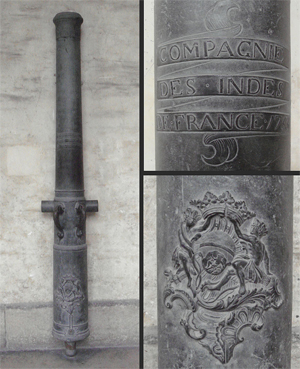
French East India Company cannon ("Canon de 4"). Bronze, 1755, Douai. Caliber: 84mm, length: 237cm, weight: 545kg, ammunition: 2kg iron balls.
The Company was not able to maintain itself financially, and it was abolished in 1769, about 20 years before the French Revolution. King Louis XVI issued a 1769 edict that required the Company to transfer to the state all its properties, assets and rights, which were valued at 30 million livres. The King agreed to pay all of the Company's debts and obligations, though holders of Company stock and notes received only an estimated 15 percent of the face value of their investments by the end of corporate liquidation in 1790.[3]
The company was reconstituted in 1785[4] and issued 40,000 shares of stock, priced at 1,000 livres apiece.[3] It was given monopoly on all trade with countries beyond the Cape of Good Hope[4] for an agreed period of seven years.[3] The agreement, however, did not anticipate the French Revolution, and on 3 April 1790 the monopoly was abolished by an act of the new French Assembly which enthusiastically declared that the lucrative Far Eastern trade would henceforth be "thrown open to all Frenchmen".[4] The company, accustomed neither to competition nor official disfavor, fell into steady decline and was finally liquidated in 1794.[3]

